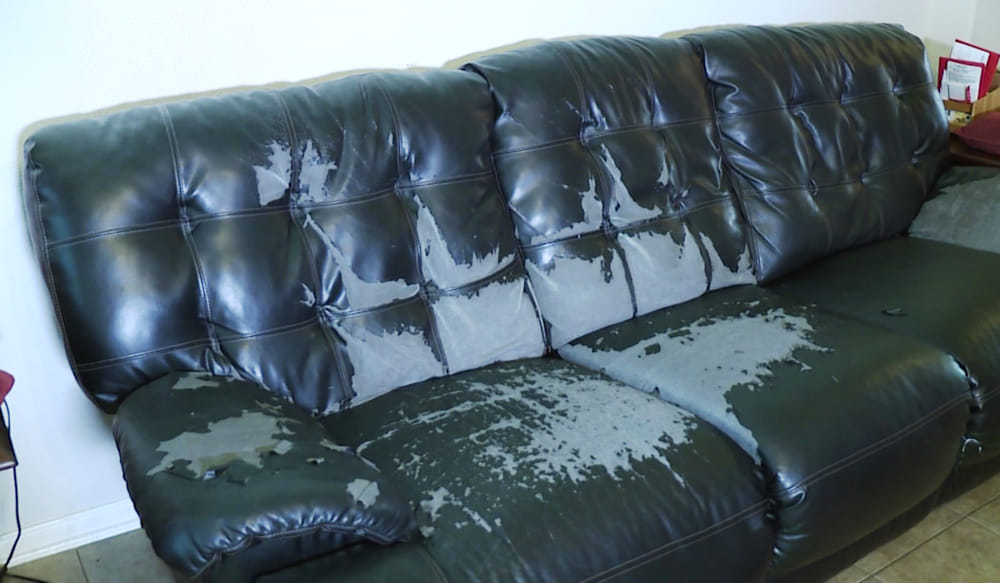
Leather is a material that is both durable and luxurious, but it does have its drawbacks. The most common problem with leather furniture is when it starts to peel or crack. This can be caused by a number of things, including the natural aging process, prolonged exposure to sunlight or heat, or even sitting on the sofa in the same spot for too long.
The good news is that there are a number of ways to fix this problem so you can get back to enjoying your leather furniture again.
How do you fix a peeling leather couch?
Remove peeled-off bits. Apply the leather paint to the damaged area. Once the paint has dried, apply the leather finish. Add extra coats of the finish.[1]
Why is my genuine leather couch peeling?
Real leather does not peel or flake. While it may just be a damaged finish or after-market paint (click here for an example), more often, peeling is a sign of a delaminating polyurethane (PU) coating on bicast, bonded or faux leather. These materials are not to be confused with vinyl (PVC).[2]
Can peeling leather furniture be repaired?
All you need is a vinyl and liquid leather repair kit that provides several tint options. This allows you to match the shade of your leather without anyone being able to tell that you repaired the peeling problem. It is important to inspect your leather sofa so you can correct all issues at the same time.[3]
How do you stop leather from peeling?
Keep Your Leather Clean. If you want to keep leather in good shape, you need to clean it regularly. Use a Leather Conditioner. Protect Your Leather from the Sun. Use a Waterproof Protectant. Know When to Contact a Professional.[4]
How long do leather couches last?
Leather furniture is very durable and lasts roughly 15 to 20 years compared with the average lifespan of a fabric couch which is about 5 years. The quality of the leather couch you purchase is the most important factor in determining longevity.[5]
How do you cover up a peeling faux leather couch?
Remove the peeling with a table knife. Apply leather wipe on the bare areas of the couch. Mix leather paint to get the desired color. Apply it onto the couch afterward. Let the paint dry and apply extra layers if necessary. Apply acrylic finisher to seal the paint.[6]
Does fake leather peel?
Durability – Faux leather is very durable and will last a long time. It can withstand scratches and scrapes that would mar genuine leather. It is not prone to crack or peel like leather.[7]
Can leather sofa be repaired?
Leather is a durable material, but after a while, it can show signs of wear and tear. The good news is that leather is easy to recondition to almost new without having to spend a lot of money to have your sofa reupholstered.[8]
How do you restore a worn leather sofa?
Clean leather sofa with a damp microfiber cloth. Use a fine-bristled brush and mild soap to clean the cracks. Apply a high-quality leather conditioner over the damaged area and let it dry.[9]
What is the best leather restorer for couches?
Top Pick. FurnitureClinic Restorative Balm Leather Couch Repair. Strong Contender. ONine Eco-Friendly Leather Couch Repair Patch. Runner Up. We Also Like. Also Great. MastaPlasta Brown Self-Adhesive Patch Vinyl & Leather Couch Repair. Numola Waterproof Leather Couch Repair Patch Kit. ONine Ultra-Thin Leather Couch Repair Tape.[10]
Do leather couches last longer?
By its very nature, leather is more durable than fabric and so will last on average last at least five years longer. And whilst fabric sofas can come with a stain repellent treatment, leather is easy to clean with just a quick wipe.[11]
What would cause leather to peel?
Using the wrong products to clean the leather can cause the leather to peel off, such as products, which contain solvents and chemicals. Even baby wipes can cause damage as the chemicals in them break down and rub the topcoat of the leather off, so while they’re safe for babies, they’re not safe for leather.[12]
